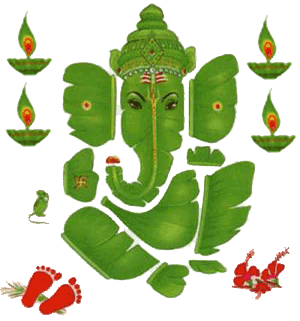




   |
| Home | About OPC | Venue | Invitatione | Programme | Photos |
| GANESH PUJA |
|
SALUTATIONS to Lord Ganesha who is Brahman Himself,
who is the Supreme Lord, who is the energy of Lord Shiva,
who is the source of all bliss, and who is the bestower of
all virtuous qualities and success in all undertakings.
Mushikavaahana modaka hastha,
MEANING: "O Lord Vinayaka! the remover of all obstacles, the son of Lord Shiva, with a form which is very short, with mouse as Thy vehicle, with sweet pudding in hand, with wide ears and long hanging trunk, I prostrate at Thy lotus-like Feet!" Ganpati is the god of learning. He is addressed as the "Remover of Obstacles" ("Vignaharta"). His devotees believe that no enterprise will succeed unless he is invoked. The picture of Ganpati is often found on the doors of houses and printed on wedding cards. On the occasion of the Ganpati festival a large number of images are made of all possible sizes, and people buy them to keep in their houses as a divine guest for one and a half, five, seven, or ten days, after which the image is taken out ceremoniously and thrown into the river, sea or well for immersion or "visarjan". When he is immersed in the water, people sing, "'GANPATI BAPPA MORYA, AGLE BARAS TO JALDI AA, " ("father Ganpati, next year come again.") It is interesting to note that the festival was not celebrated until the times of Lokamanya Bal Gangadhar Tilak, who used it a great means to unite Hindus all over India and educate them the evils of colonization. The festivities include fund-raising, building all kinds of innovative forms Ganesh idols. Organizing public performances of music and dance, cooking grand feasts and making a lot of noise. The festivities end when the idol of the year is immersed in water (visarjan). Lokamanya Tilak (portrait - biography) visualized the cultural importance of this God and brought in Ganesha Chaturthi as National Festival. It was an important festival during Peshwa rule in Maharashtra, but acquired more organized All India from during the Swaraj movement (see Tryst with Destiny -- The story of India's struggle for freedom remains as a guiding light for resolving the various conflicts around the globe). It made way for learned discourses, dance dramas, poetry recital, musical concerts bringing together all castes and communities who vied with enthusiasm in organizing this public festival. The all-pervading Gajanana (another name of Ganesh) has countless temples all over India and is worshipped with more affection than awe in every Hindu home. Puja
As Lord Ganesha is considered to be the common avatar of both Lord Shiva and Lord Vishnu, he is worshipped by both the hindu sects, the Shaivites and the Vaishnavites. During festival of Ganesh Chaturthi, the idol of Ganesha is installed in an altar at home. The family members along with the help of a pandit (a hindu priest) perform puja (prayers) at home every morning and evening. They place offerings like flowers, rice & coins in front of the image of Lord Ganesha. In the prayers that follow, it is customary to make 108 salutations to Ganesha. They read shlokas (invocation) and the Ganesha upanishad. Aarti (worship with a holy flame) is performed and hymns are sung. The singing of hymns has become a popular event during this festival. |